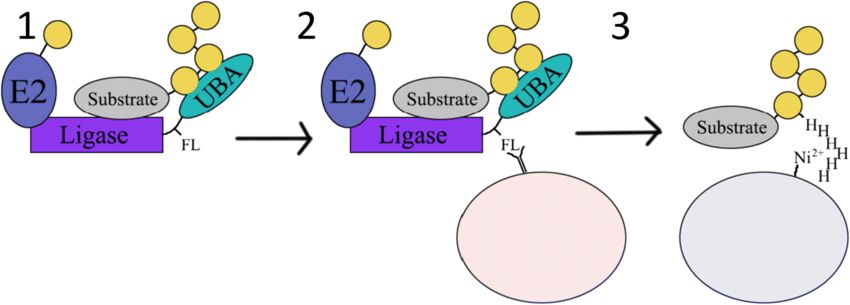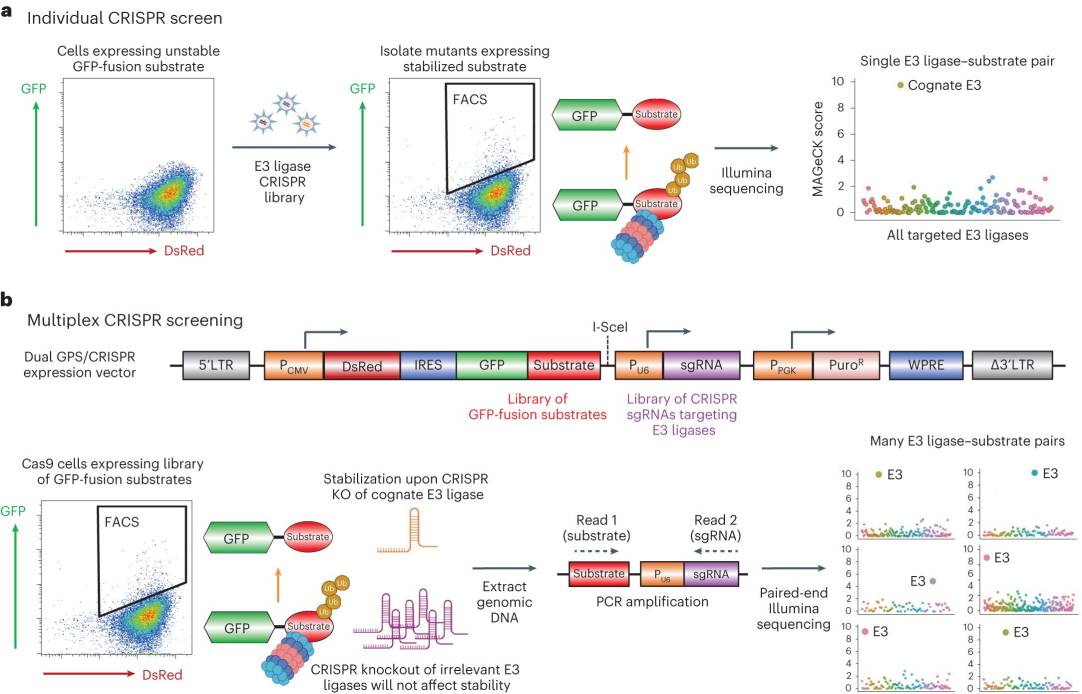Ligase Substrate Profiling is a critical scientific study that aims to understand the details of enzyme activity, particularly ligase enzymes. These enzymes are vital for joining molecules together. This research is invaluable as it offers deep insights into various biological processes. Through Ligase Substrate Profiling, we can enhance our understanding of life sciences and contribute significantly to important fields like drug discovery. It also helps us comprehend the mechanisms behind various diseases, paving the way for potential healthcare breakthroughs.
 Ubiquitin ligase–substrate trapping (Stephanie Rayner, et al., 2019)
Ubiquitin ligase–substrate trapping (Stephanie Rayner, et al., 2019)
Service Process
Our Ligase Substrate Profiling service process is comprehensive and customized to meet your specific needs. The process entails:
- Initial Consultation: We begin with an in-depth consultation to understand your requirements and expectations fully, discussing your objectives, current project understanding, and any specific questions or concerns.
- Experimental Design: Using the information from the consultation, we design the experiment. This stage includes developing an action plan, outlining the methods, and determining the necessary resources, ensuring the profiling process meets your objectives.
- Execution of Profiling: After finalizing the experimental design, we execute the profiling. Our expert team carries out the Ligase Substrate Profiling with meticulous precision. We conduct the execution phase with utmost care to ensure accurate and reliable results.
- Data Analysis: Post-profiling, we thoroughly analyze the data. Our data analysts interpret the results, identifying patterns, trends, and significant findings. Comprehensive Report: We conclude by compiling all our findings into a comprehensive report. This report includes a detailed explanation of our methods, findings, their significance, and our interpretations and conclusions based on the data analysis.
This detailed process ensures our Ligase Substrate Profiling service is thorough, accurate, and specifically tailored to your needs. If you have any questions, need more information, or would like to discuss a potential project, please don't hesitate to contact us. Our team is always eager to help and share our expertise.
Applications
| Application |
Description |
| Drug Discovery |
Ligase substrate profiling is vital in drug discovery, facilitating the identification and characterization of ligase targets for therapeutic intervention. By elucidating the substrate specificity of ligases, researchers can design inhibitors to modulate ligase activity, offering potential treatments for various diseases such as cancer, neurodegenerative disorders, and metabolic syndromes. |
| Ubiquitin Signaling |
This technique enables a comprehensive analysis of ubiquitin ligase function, shedding light on their roles in cellular processes. By profiling ligase substrates, researchers can gain insights into ligase activation, substrate specificity, and ubiquitination dynamics, facilitating the understanding of ubiquitin-mediated signaling pathways, protein degradation, and cellular regulation. |
| Protein Degradation Pathways Study |
Ligase substrate profiling plays a crucial role in studying protein degradation pathways, including the ubiquitin-proteasome system and autophagy. By identifying substrates targeted for ubiquitination by ligases, researchers can unravel the mechanisms underlying protein turnover, protein quality control, and the regulation of cellular homeostasis. This knowledge contributes to the development of therapies targeting protein degradation pathways for the treatment of various diseases, including cancer and neurodegenerative disorders. |
| Biomarker Discovery |
Ligase substrate profiling enables the discovery of ubiquitination signatures associated with diseases, serving as potential biomarkers for diagnosis, prognosis, and monitoring of treatment response. By identifying ligase substrates and their ubiquitination patterns in biological samples, researchers can develop biomarker panels for various conditions, offering non-invasive diagnostic tools and personalized treatment strategies. |
| Biomarker Discovery |
Ligase substrate profiling enables the discovery of ubiquitination signatures associated with diseases, serving as potential biomarkers for diagnosis, prognosis, and monitoring of treatment response. By identifying ligase substrates and their ubiquitination patterns in biological samples, researchers can develop biomarker panels for various conditions, offering non-invasive diagnostic tools and personalized treatment strategies. |
Case Study
Specificity within the ubiquitin–proteasome system is predominantly orchestrated by E3 ubiquitin ligases. However, for numerous E3 ligases, identifying their substrates, particularly the molecular features (degrons) they recognize, remains a significant challenge. The figure below demonstrates a method for high-throughput identification of E3 ligase substrates using a multiplex CRISPR screening platform. a, Individual FACS-based CRISPR screens are highly effective at identifying the cognate E3 ligase for unstable substrates tagged with a fluorescent protein such as GFP, but suffer from limited throughput as they are only capable of analysing a single substrate per screen. b, In contrast, multiplex CRISPR screening aims to identify the cognate E3 ligases for tens or hundreds of substrates in a single experiment. By encoding a library of GFP-tagged substrates and CRISPR sgRNAs targeting E3 ligases on the same lentiviral vector, cells expressing stabilized substrates paired with an sgRNA targeting the cognate E3 ligase can be enriched by FACS and the combination identified by paired-end sequencing.
 Defining E3 ligase–substrate relationships through multiplex CRISPR screening (Richard T. Timms, et al., 2023)
Defining E3 ligase–substrate relationships through multiplex CRISPR screening (Richard T. Timms, et al., 2023)
FAQs
Here are some common questions and answers about Ligase Substrate Profiling, providing detailed insights into this specialized field of study. If you have more specific or detailed questions, don't hesitate to get in touch with us directly.
Q: What exactly is Ligase Substrate Profiling?
A: Ligase Substrate Profiling is a specialized field of study that focuses on understanding the activity of ligase enzymes. Ligase enzymes are vital to many biological processes as they play a key role in joining molecules together. This fundamental process is essential to the functioning of life at a molecular level. By studying these enzymes, we can gain deeper insight into the intricacies of how life functions at a biochemical level.
Q: Why is Ligase Substrate Profiling deemed important?
A: Ligase Substrate Profiling is of immense importance for several reasons. Firstly, it enhances our understanding of various biological processes, providing insights into the workings of life at a molecular level. Secondly, it serves as a critical tool in drug discovery. By understanding how ligase enzymes function, we can develop drugs that interact with these enzymes in ways that can treat a variety of diseases. Lastly, it contributes significantly to the understanding of various diseases. Many diseases are caused by the malfunctioning of enzymes, so understanding how these enzymes function can pave the way for potential treatments.
Q: What are the potential applications of Ligase Substrate Profiling?
A: Ligase Substrate Profiling has vast potential applications. It can be applied in pharmaceutical research for drug discovery, in biotechnology for the development of new technologies, and in academic research to advance our understanding of biology. Moreover, it can also be leveraged in disease study to comprehend disease mechanisms at a molecular level, potentially leading to the development of new treatments.
Q: How does Ligase Substrate Profiling contribute to drug discovery?
A: Ligase Substrate Profiling contributes to drug discovery by providing insights into enzyme function. By understanding how ligase enzymes work, scientists can develop drugs designed to interact with these enzymes. This could include drugs that enhance enzyme function, inhibit it, or modify it in some way. Such drugs could be used to treat diseases that are caused by the malfunctioning of these enzymes.
Q: What is the process of undertaking Ligase Substrate Profiling?
A: The process of Ligase Substrate Profiling involves several steps. Initially, a consultation is undertaken to understand the specific needs. Following this, the experiment is designed in detail keeping in mind the objectives of the project. The profiling is then executed meticulously, followed by an extensive analysis of the data. Finally, a comprehensive report detailing the findings is delivered.
Q: What fields can benefit from Ligase Substrate Profiling?
A: Several fields can benefit from Ligase Substrate Profiling. This includes pharmaceuticals, where it can aid in drug discovery, biotechnology, where it can contribute to the development of new technologies, and academic research, where it can enhance our understanding of biology. Additionally, it can be beneficial in the study of diseases, providing insights into disease mechanisms at a molecular level.
Q: How can Ligase Substrate Profiling contribute to understanding diseases?
A: Ligase Substrate Profiling can contribute to our understanding of diseases by providing insights into how ligase enzymes function. Many diseases are caused by the malfunctioning of these enzymes. By understanding their function, we can gain insights into the disease mechanisms at a molecular level, which could potentially lead to the development of new treatments.
Q: What is the technical route of Ligase Substrate Profiling?
A: The technical route of Ligase Substrate Profiling involves several steps. It starts with an initial consultation to understand the specific needs, followed by a detailed design of the experiment. Then, the profiling is meticulously executed, followed by an extensive analysis of the data. Finally, a comprehensive report detailing the findings is delivered.
Q: What are the challenges in Ligase Substrate Profiling?
A: Ligase Substrate Profiling involves complex biochemical processes, and as such, presents certain challenges. These might include ensuring the accuracy of the profiling, conducting meticulous data analysis, and interpreting the results in a meaningful way to draw valid conclusions. Moreover, the need for highly skilled professionals with expertise in enzymology and biochemistry is also a challenge in this field.
Q: How can one avail of Ligase Substrate Profiling services?
A: Our Ligase Substrate Profiling services can be availed by reaching out to us via our contact details. We offer comprehensive services tailored to meet specific needs. Our process begins with a detailed consultation to clearly understand your requirements. This is followed by designing the experiment, executing the profiling, analyzing the data, and finally, delivering a comprehensive report detailing our findings.

































 Ubiquitin ligase–substrate trapping (Stephanie Rayner, et al., 2019)
Ubiquitin ligase–substrate trapping (Stephanie Rayner, et al., 2019) Defining E3 ligase–substrate relationships through multiplex CRISPR screening (Richard T. Timms, et al., 2023)
Defining E3 ligase–substrate relationships through multiplex CRISPR screening (Richard T. Timms, et al., 2023)